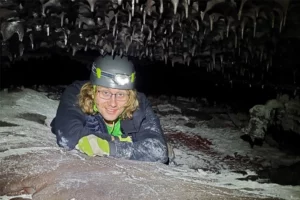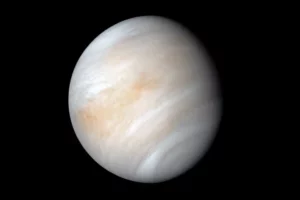Mars seems to get all the attention when it comes to interplanetary study, but Earth has another neighbor that’s shrouded in mystery – and a thick layer of yellow clouds. Venus is a barren, rocky planet that has long fascinated scientists. NASA has radar-mapped its surface and has taken photographic images of the planet, but it has never collected data on the ground.
That’s because “unlike Mars, it’s really hot,” explained UWM graduate student Dylan Childs. “Like really, really hot.”
In fact, he said, the Venusian surface averages 460 degrees Celsius, or about 870 degrees Fahrenheit. That’s far too hot to land any spacecraft. The Soviets tried in 1975 and again in 1982; their probes broke down within an hour of arriving.
Though it’s difficult to study, scientists are interested in the planet because Venus is similar to Earth in many ways, and is often nicknamed “Earth’s twin.” They are roughly the same size and are made from many of the same materials, but for some reason, Childs said, Venus experienced a “runaway greenhouse effect” at some point as recently as one billion years ago, rendering its surface desolate and hot.
But how does one study a planet like Venus here on Earth? If you’re Childs, who is set to earn his Master’s degree in geosciences this spring, you search for a place on Earth that has similar conditions to the Venusian surface: Someplace dry, with a lot of gaseous vapors, that is really, really hot.
Say, for example, a volcano.
The minerals in lava tubes
Childs completed his undergraduate degree at UWM before returning to work on his Master’s. He studies planetary geology, and he’s especially interested in what minerals may be present on the surface of Venus.
To find out, he visited lava tubes in Hawaii.

“(Lava tubes) look just like cave systems,” Childs explained. “When you have lava flowing down the slopes of a volcano, it can channel and produce a river. The outer surface of this river is exposed to the cooler atmosphere and will solidify first … and can form a roof for the still hot, still flowing, lava interior.”
Over time, he added, the lava will wear through the earth beneath it, leaving behind a cavern. Lava tubes remain insulated from the air on Earth’s surface and can maintain their superheated environment for months to years later.
“For my (research), we wanted to see what minerals grow in this environment in these caves and see, do they grow in a hot environment and a dry environment?” Childs said.
Childs collected mineral samples from chunks that had broken off the sides and ceilings of the lava tubes – areas that would have been exposed to the heat of the lava without being under the lava. Then, he took them back to the lab at UWM for analysis. With x-ray diffraction, he could identify the secondary minerals present in his lava tube samples – hematite, magnesioferrite, cristobalite, tridymite, and gypsum.
Then, using other methods like visible near infrared spectroscopy and scanning electron microscopy, Childs began to infer the processes under which those minerals formed. He found that the surface of his samples were entirely composed of metal ions, while the interior looked more like a normal basalt rock. That meant there was evidence of a process called “metal migration.” Essentially, Childs said, the high temperatures created a powerful oxidizing environment, which pulled out electrons and fed more metal ions to the surface of the rock to compensate for the change in charge.
His work shows that some of these minerals do form in hot, dry environments, and that Venus may therefore have similar minerology. Childs can’t say how close the lava tubes are to conditions on Venus, but “definitely we’re on to something here.”
Magnets in lava tubes
If Childs is interested in minerals, then Terra Johnson is interested in their magnetism. Johnson, who uses they/them pronouns, is an undergraduate researcher majoring in geosciences. They are set to graduate this May and plan to attend UWM for graduate school next year.
Their research seeks to uncover the varying types and abundance of magnetic minerals that are found in oxidized versus unoxidized environments – i.e., inside of the lava tubes versus outside of them.

“When you have an oxidized sample, as Dylan was explaining, you would expect more iron-rich minerals, or more magnetic minerals like hematite, on the surface (of the sample),” Johnson said.
To find those minerals, Johnson borrowed Childs’ samples from the lava tubes and measured their coercivity. This measures a magnetic material’s ability to resist an external magnetic field and retain its original alignment. Certain materials have higher coercivities than others. By determining coercivity, Johnson can make a guess as to what minerals are present in the samples, and how much of them there are.
“So if I’m a hematite grain pointing one way, I need a much stronger field to flip my magnetic direction the other way than if I was magnetite,” they explained. “So we can do those tests, and I’ll have graphs with a huge curve showing low coercivity minerals, which are probably more magnetite, and then a smaller curve with higher coercivity, which is more like hematite.”
They compared samples taken from the inside and outside of the lava tubes, and found that the samples from inside “had a much more complicated magnetic profile than the stuff outside,” which is a good indicator of the presence of an oxidative environment.
Johnson said that their research adds to the body of Childs’ work, and could help explain why there is a reddish color to Venus’ surface – perhaps there is a hematite or iron oxide product present.
Childs and Johnson presented their research at the Geosciences Research Symposium in March, and their work adds to a growing body of knowledge about Venus. This type of research is important, Johnson said, because the more we can understand about Earth’s twin and why it’s so different from Earth, the more we can understand about how planets form, evolve, and thrive – or die.
By Sarah Vickery, College of Letters & Science
